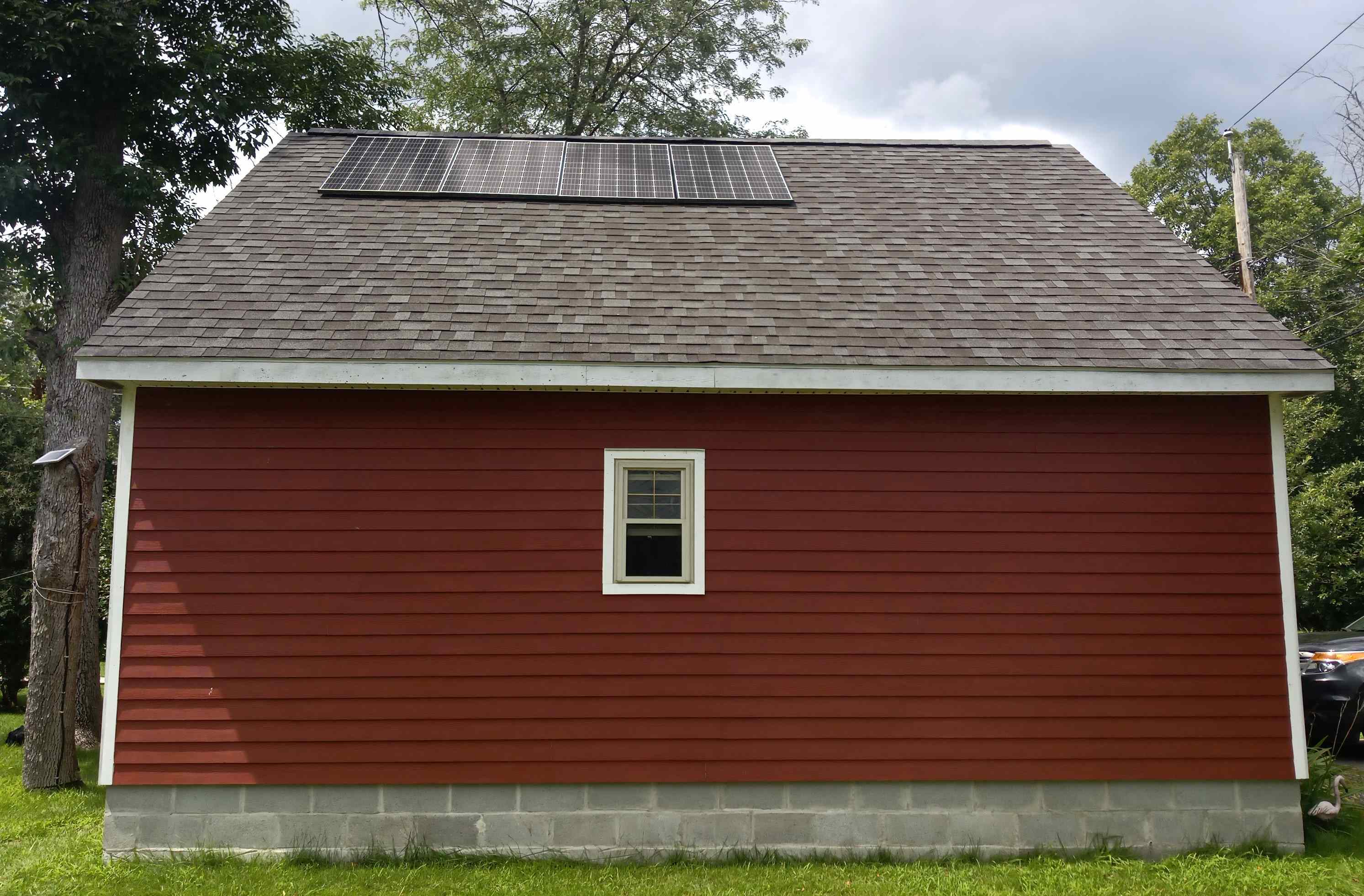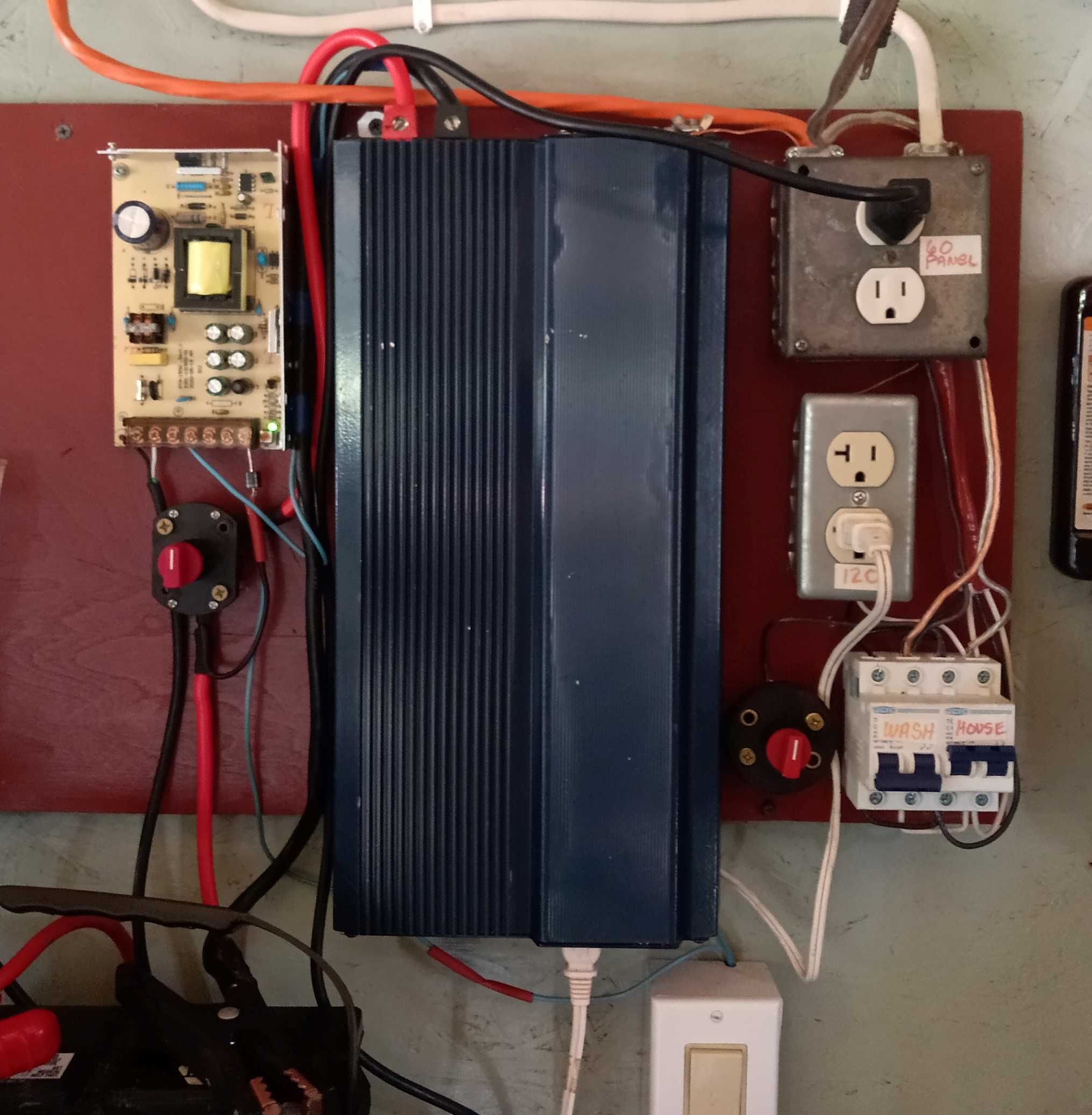And now for something completely different.
For the last three years I have done my laundry with the power from four Trina 226W 30V grid tie panels. No
battery, just an old MSW inverter where the series string is fed right to the high voltage capacitor of the
H bridge output. We line dry so the laundry is only done on nice days. A little 12V 1.5A LED switching regulator
provided the power for the control electronics. The 12 to 159V boost inverter section was never used. All cycles
used hot water from the laundry's own 40 gallon hot water tank. The loads would come out steaming. The is a LG
front load washer and front loaders are notorious for mold smell. This one doesn't because the hot water completely
cleans the dispenser tray. I have to clean the same washer at home because of mold buildup every couple years when
the fill tube turns black. Usually when the pump goes bad.


Hot water is provided by excess power diversion using my PV hot water controller board. This operates on 60V PV
array voltage. It senses when PV voltage goes over the power point of 60V and diverts just enough current to bring
the voltage down to power point. Hot water tank has two 5500W 240V heating elements. These are wired in parallel,
each with its own thermostat. I didn't find it necessary to replace them with 2000W 120V elements and switch from
higher to lower. With both on, the lower section of the tank acts like a pre heater. The upper 15 gallons is usually over
110F. Laundry is only done about every two to three days. That gives the tank enough time to recover. I've done three
loads in a day and still had hot water over 80F.
The transfer switch puts the four panels in series for 120V for the washer. The water heater at 60V and continues to
uses a pair of panels. In a fill cycle the water heater will divert excess power. The red switch on the right
disconnects the array from the house system. Power can go both ways. The East facing panels on the garage produce
a lot of power in the morning and provide the substantial amount of power for the domestic hot water of the house.
60C water is available for the dishwasher by 10am. With both transfer switches down, I have a totally isolated 60V
string of two panels to power experimental projects.


The red switch on the left disconnects the battery from the inverter. This is where it gets interesting. For three
years I haven't had problems getting a nice day to do laundry. On occasion a little cloud will pass over and the
laundry will stop with a DE1 failure (low voltage). I am usually working in the garage and just wait for the cloud
to pass. The machine remembers where it was and I just press start. Totally no battery laundry. I carted off to
recycling a perfectly good washer just to get this direct drive which doesn't have large startup surges. The two
year old LG washer was only $150 delivered because it didn't work. It still had the LOWES delivery tag with the
date. The guy lamented not getting the extended warranty. He had also stored it for a while and evidently put
something heavy on it. The only issue was a button stuck in and a little file to the plastic solved that. The hot
water tank was also free. The cold water plastic down fill tube inside had broken off and cold was immediately
misxng with the hot. I just feed cold water into the drain port. We are in a high lime area and I removed enough
sediment to fill a 5 gallon bucket. The screenshot shows a half hour of scattered clouds and rapid diversion to
water heater of excess energy.

Back to the battery. The last two months have been the worst weather I have ever seen. There has also been the
smoke from Canada. It was like we were in fog. I couldn't get laundry done as a sunny day clouded over and never
returned to sun. I would have to run the generator and sometimes the machine would forget where it was. The load
would have to be started all over. I went to what I call battery assist. When array voltage dropped to 110V DC,
just below power point, the inverter boost secion would come on and provide just enough power to make up what the
array couldn't provide. I did this by changing the HV sense resistor and bringing the voltage from 159V down to
110V. It is a 2,000W inverter with seven boost transformers. This blending of power is what some inverter AC
units use which have solar assist. This can be used in many applications. I removed the fuses from five of them
to make it a 500W inverter. Initially I had just used an inverter out of an emergency 12V battery pack which was
only 300W. These are thrown out all the time and I get them at recycling. I don't think any of them have ever saved
anyone. They just get thrown out because people forget to charge them. I used that for a long time, but it was an
open circuit board. One day I dropped a powered wire into it. I figured it needs a case and have a bunch of these
2,000W Harbor Freight inverters.
With this blending a lot of power from the inverter is not needed. Absolute peak from washer is only about 550W
without heating elements coming on. I set the washer on COLD TAP to prevent that from happening and that can be
programmed into the washer's memory. Most of the time the washer consumes less than 250W and average for a complete
wash cycle is only 100WH. The battery is from town recycling and likely only has 10AH at best. I thought so little
of the battery I didn't even put it on a battery maintainer the seven months I was gone. Surprised to see it was
at 12.4V when I arrived.
To keep the battery charged I use a 120W 120VAC LED 12V switching power supply. It is modified to work on 60V DC
and voltage is boosted to 14.1 volts. That feeds thru a diode to maintain the battery at 13.8V. I have seen the
inverter pull over 20A from the battery in heavy clouds. Typically, in light clouds it uses less than 10A with
moderate clouds with the panels being able to supply the majority of power. The inverter control electronics is
supplied thru a 3A fuse. Just in case the 12V main power switch is off and somehow the inverter power switch
is turned on. That could put 20A thru the inverter light ribbon cable and burn up. I've been known to have
lapses in memory.
Stand alone laundry with hot water only cost $500 including washer and it also supplies power to the house. No
strain on the house charge controller and battery. Notice the pressure meter on top of the tank? That is a long
3/4 inch pipe used for expansion. Not nearly enough because solar heating experiences wide temperature swings.
I couldn't find a cap for the pipe so used a pressure gauge. From zero presure it will go up to 90 psi from
expansion. I built the garage about a dozen years ago. Water to the garage is thru a garden hose. By local
code, if you want water to a detached garage it has to have a separate water meter. I get free solar thermal
heating from the 100 foot of garden hose.